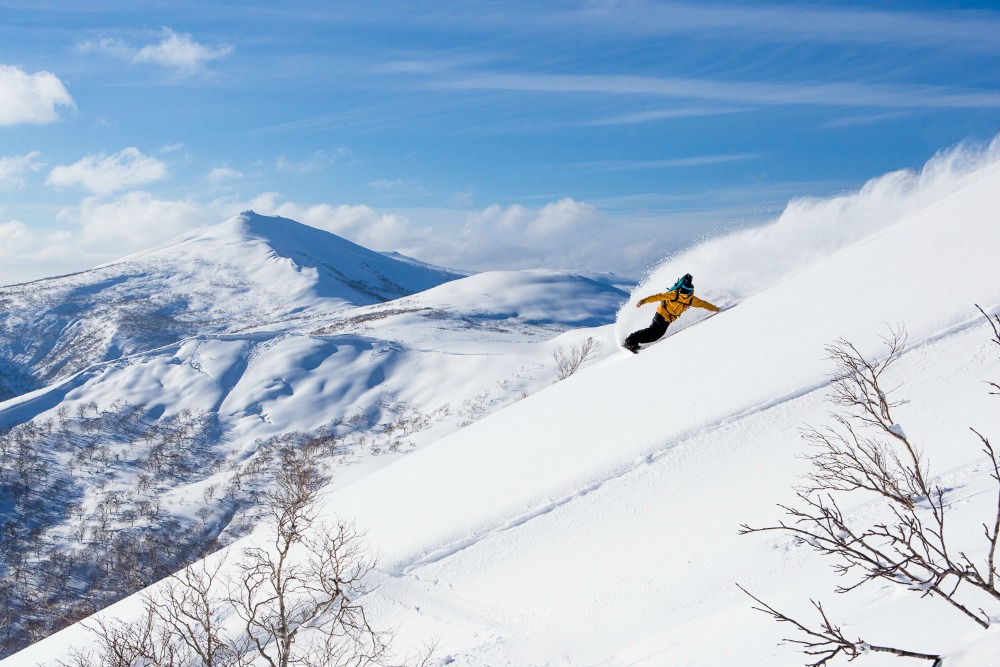Snow Surfing with Chris Christenson and Jeremy Jones
In 2006, San Diego surfboard shaper Chris Christenson found himself standing on top of a mountain in Niseko, Japan, during a bluebird powder day, strapping into one of Taro Tamai’s legendary Rocket Fish snowboards. He’d traded Tamai, an enigmatic Japanese style master and original “snow surfer,” a surfboard he’d recently shaped for the Rocket Fish and this would be his first time riding it. Mentored by masters of the craft like Skip Frye, Dick Brewer, and Rich Pavel, Christenson started shaping surfboards when he was 18 and launched his own business at age 19 out of his dorm room. Nowadays, Christenson’s surfboards are known and sought–after all over the world and he has a well-earned reputation for working hard, making beautiful, fast boards in all shapes and sizes, having an open mind, and being willing to try new and unconventional designs.
“This was before Niseko had really blown up,” Christenson recalls of that fateful day, “so not that many people were around and there were all these amazing, wide open, untracked pow lines right under the lift.” A lifelong surfer and snowboarder with an innate DIY design ethos, in the late ’70s and early ’80s Christenson attached bicycle inner tubes to his old skateboard decks and slogged up the low–angle slope behind his grandfather’s cabin near Big Bear in the San Gabriel mountains. “Sliding around on the snow with my old skate decks and then snowboards, all I wanted to do was imitate what I felt on my surfboard in the ocean,” Chris explains. “It took 25 years, but on that day in Niseko riding Tamai’s Rocket Fish, I finally found the feeling I was looking for. That board…in those conditions…it felt like I was surfing a really good wave. There was so much flow and glide, like riding a perfect point break with no one out.”
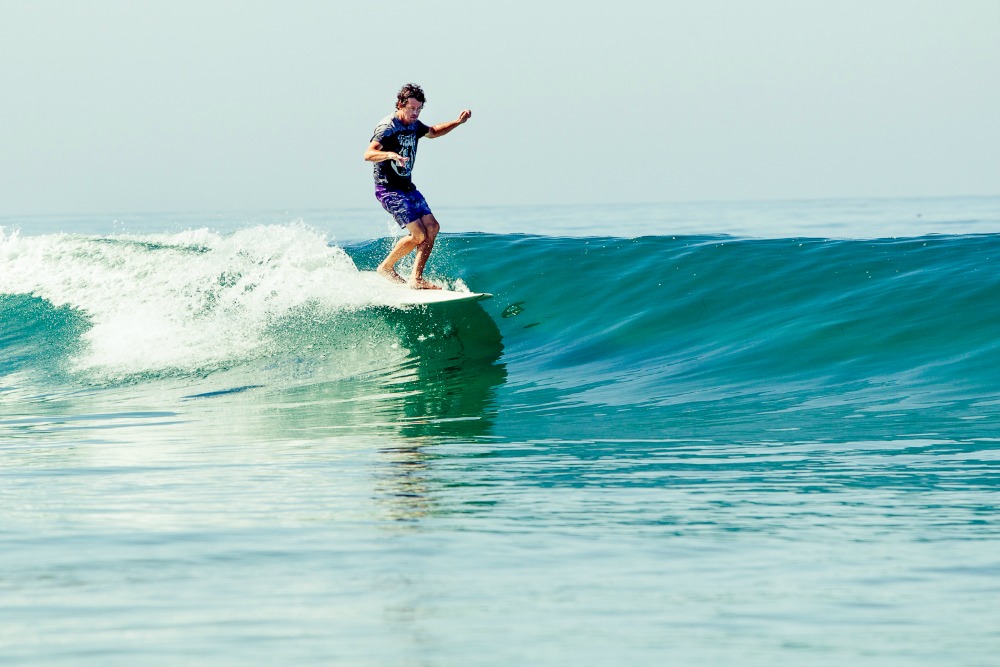
After that first day in Japan, Christenson was hooked on snow surfing. “I couldn’t get enough of it. Two weeks later I was back in California and ended up chasing a storm from San Diego to Mammoth,” Chris says. “After scoring another great day on the Rocket Fish, I immediately found a room to rent in Mammoth so I could keep chasing those storms.” Thirteen years later, Christenson is still fully committed to the mountain/beach lifestyle. He owns a cabin outside of Mammoth along with a place in Cardiff–by–the–Sea, a small beach town in North County San Diego. Routinely logging 100+ days on the snow and in the ocean every year while running a full–time business that produces some of the highest quality surfboards in the world keeps him busy. The surf and snow keep him inspired. “I think I have the ‘working man’s record,’” Chris says with a laugh. “I currently have 21 employees and work at least 2,000 hours a year, so getting more than 100 days in both the surf and snow feels pretty damn good.”
At roughly the same time that Christenson was rediscovering his love of snowboarding, professional snowboarder Jeremy Jones and a host of other progressive shredders like Travis Rice and Xavier De Le Rue were redefining the sport, forging a new path riding big mountains without the assistance of helicopters or snowmobiles. In 2009, when Jones and TGR released their seminal film DEEPER, Jeremy was also getting ready to launch his eponymous company, Jones Snowboards. Inspired all his life by stylish surfers like Tom Curren, along with snow surf icon Craig Kelly, Jones was on a mission to build a snowboard that would have the same type of free–friction glide as a good surfboard. Growing up, the cold North Atlantic waves that were 45 minutes from his family’s house in Cape Cod captivated him and Jones connected with surfing early on in his life. “Before snowboarding even existed for me, I knew I was a surfer,” Jones says. “We would skateboard down the street pretending we were surfing, then scrape together rides to the beach, paddling around on busted–up old boards in leaky wetsuits, having the best time.” Now that he was starting his own snowboard company, Jones was hoping to infuse some of those snow surf concepts in his boards. “I wanted to bring actual surf design concepts and hydrodynamic principles into the boards,” Jones explains. “Not just like…put a swallow tail and a surfboard graphic on them, but do it really from the ground up, and I was struggling to find someone who could make that link happen.”
“In 2009, I was obsessed with DEEPER,” says Christenson. “The way Jeremy and those guys were riding mountains and big lines was really inspiring to me.” It all came together during the Thanksgiving holiday in late 2009 at a beachside campground in Cardiff. Jones and his family were there camping with Jeff Kelley, the founder of a sandal company called Sanuk, who had recently sponsored their first snowboarder, Jeremy Jones. Kelley and Christenson were longtime friends, so when Jeremy started asking about surfboard shapers who were also serious snowboarders, Jeff immediately thought of Chris. According to Jones, “As soon as he heard what I was looking for, Jeff said, ‘You gotta meet Chris Christenson.’”
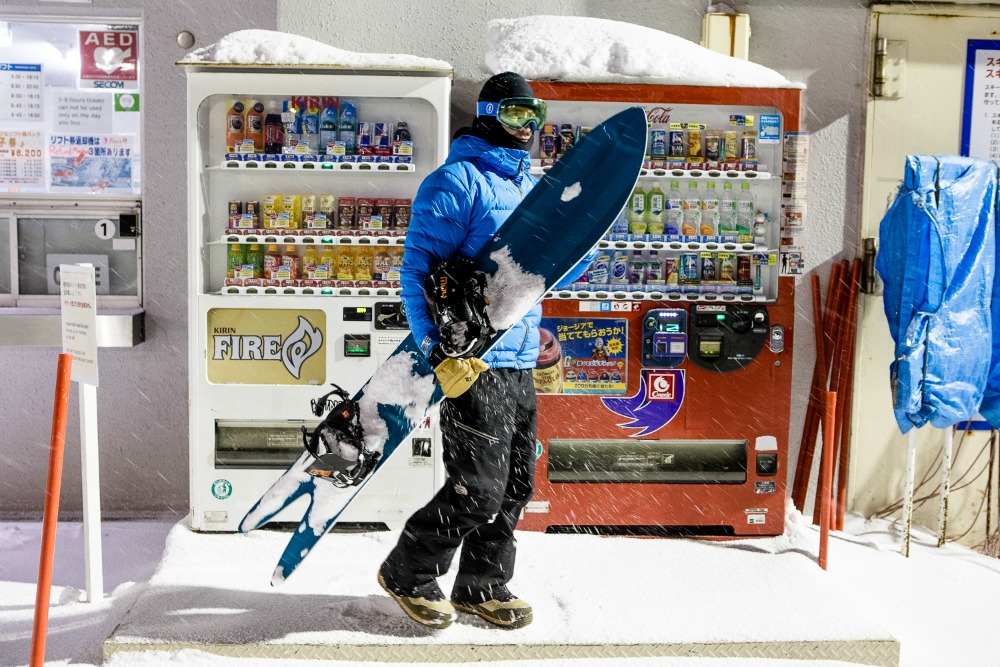
“I’d just gotten back from a trip to Mammoth,” remembers Chris, “and I ran into Jeff on the beach, and he said there was someone he wanted me to meet, a snowboarder named Jeremy Jones, who was camping with him. I was like, hell yeah I want to meet him!” Jumping at the chance to meet his snowboarding hero, Chris brought over a few beers and Jeff introduced them.
When Jeremey Jones met Chris Christenson around that campfire, something special happened. The universe clicked. Conversations of surf, snow, and the glide that unites them set their imaginations raging. “It was obvious to me, really, really quickly,” says Jeremy, “that Chris was the person I’d been looking for.”
“We got introduced and Jeremy said he’d been waiting a long time to meet a surfboard shaper who was also passionate about the snow,” Chris explains, “and I was like, ‘Yeah, you guys are doing it all wrong!’”
From the mid-late ’90s through the mid-late 2000s, snowboards hadn’t changed much design–wise. Most of the pro models were symmetrical twin tips, perfect for the terrain park and half pipe but difficult to carve on and hard to ride in soft snow. “All the major labels’ boards were pretty much the same back then,” Christenson explains. “It was more a graphics game than anything. Directional, soft-snow specific boards were what I was into, and nobody was making them besides Taro, even though that’s where snowboarding’s roots are.”
A quick glance in snowboarding’s rearview mirror reveals the truth in Christenson’s statement. It all began with Sherman Poppen’s Snurfer in 1966 and ran through Dimitri Milovich’s Utah–based company Winterstick and their “Snow-Surfboard” patents in 1974. Even the early Sims and Burton board designs of the ’80s were focused on ‘surfing down the mountain.’ That changed with the emergence of terrain parks in the ’90s. Snowboarding started to look more towards skateboarding’s technical tricks and hard-core culture than surfing’s sun–bleached style and laid–back glide.
Jones offers this assessment: “From a cultural perspective, sometime in the mid-’90s, the sport made this decision—we are going to be the next skateboarding and we are going all–in on freestyle snowboarding, which is great and the terrain park is this beautiful thing, but I think that we ended up creating this atmosphere of, if you’re not learning a new trick, get out of the sport. We got away from this wonderful part of snowboarding—getting to strap in on the top of a mountain and surf down. The simple act of turning and top–to–bottom snowboarding kind of went away for a while.”
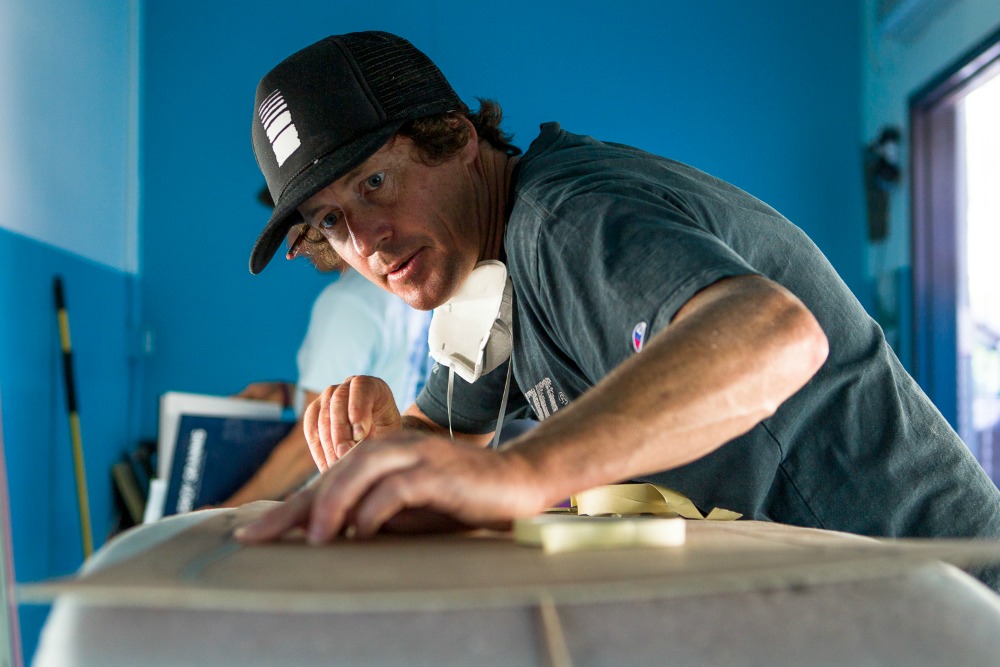
Back in Cardiff, Christenson showed up the very next morning at the Jones camp with a bunch of different surfboards for them to try. There was one in particular, though, that Chris was especially excited to show Jeremy. “He handed me this wild–looking, super–short twin fin,” Jones says. “I think it was a 5’1 Ocean Racer model. I’d never surfed on anything shorter than, like, a 5’10”, but Chris said it had the fastest bottom contours he shapes.” It didn’t take Jones long to understand what Chris meant and want to learn more. “The first wave I caught on that board,” Jones says, his voice rising with the memory. “Man, it was just…wow, does this thing fly! I was totally blown away. By that afternoon, we were in his shop cutting out templates and bending plywood.”
United by the pursuit of glide, the two became fast friends. Jones offered to take Christenson into the backcountry around his home in Lake Tahoe. Chris was more than game and a few weeks later they were skinning up Deep Creek together. It was Christenson’s first backcountry tour and by the end of it, two things were obvious. He needed to get a split–board of his own and a design partnership with Jones was a reality.
Their first model together was the Mountain Surfer, a board ridden without bindings that has a similar rocker and bottom contours as the Ocean Racer twin fin which left such a strong impression on Jeremy. After shaping the original mold by hand, Christenson sanded away all the foam so that just the fiberglass contoured base remained. Picking up one of the Mountain Surfers, he turns it over slowly and runs his eyes down the base of the board, saying, “You can see the slight roll in the convex nose, which moves into a single concave down through the tail, just like a catamaran.” Designed totally in analog—drawing a template, cutting out the shape, and sculpting the bottom by hand—everything was done by feel and look. The results were dramatic.
“The first time I called the engineers [at Jones Snowboards] and said we’re going to make a pow surfer and these are the dimensions, they thought I was crazy,” recalls Jones. “They said, ‘147cm long (4’9”) and 28cm (11”) wide, huh? With a convex nose and concave base? Really?’ but as soon as I rode that original pow surfer with Chris’ bottom contours, it immediately turned into my go–to board on any good snow day. I loved it. I was finding feelings I’d never felt before on the snow. I could roll into turns like being on a surfboard and the glide it carried was similar to surfing down the line on a smooth wave. Eventually, there was only thing I wanted to change…I started to really want bindings on it every once in a while, and that’s where the original Storm Chaser board came from.”
It took some time to figure out how to produce and replicate Christenson’s intricate hand–shaped bottom contours in a snowboard factory setting, as the bases of every other snowboard were flat, but they eventually made it work. Along with the Mountain Surfer and Storm Chaser, Jones x Christenson added the long and narrow high–speed carving Lone Wolf model and the more moderate–looking but still directional and surf–inspired Mind Expander and Ultra Mind Expander to their quiver. All the models are available as split-boards. A split-board, much like the name implies, comes apart in the middle, allowing riders to use skins and tour in the backcountry on the more maneuverable skis without having to carry the board on their backs.
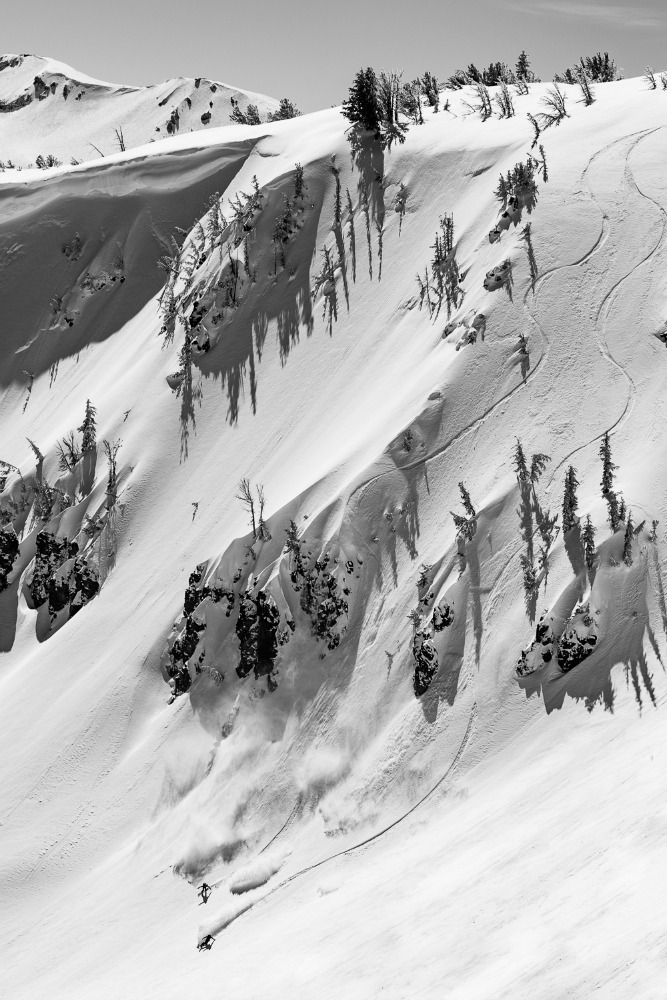
“My whole theory on snowboards,” Christenson says, “is that they’re all a bunch of one-trick ponies with these twin tips. It’s gotta go back to surfing, where you’ve got a quiver of different boards for different conditions because the snow and terrain you want to ride changes just like the surf does.”
While the Jones x Christenson collaboration is one of the more recent iterations of snow surfing growing in popularity and cultural cross-pollination, they’re both quick to point out that they’re not the first. Both say unequivocally that what Taro Tamai and his company Gentemstick have been doing in Japan for decades is their major source of inspiration. “We owe Taro a lot of credit,” Christenson says. “He’s an absolute legend.”
One thing is certain. Snow surfing down the mountain is definitely coming back into style. “It might have gone away for a while,” Jones says, “but it’s definitely back now with all these surf shapes. I think it’s a positive thing and I’m happy to see it happening…it’s accessible and a whole lot of fun.”
What does the future hold for snow surfing and the Jones x Christenson design collaboration? “We have no idea what’s next,” says Jones. “That’s the beauty of it. There’s no definitive long–term road map. For me it’s all about being out there in the mountains and ocean with an open mind and eyes wide open and seeing where this ride takes me.”
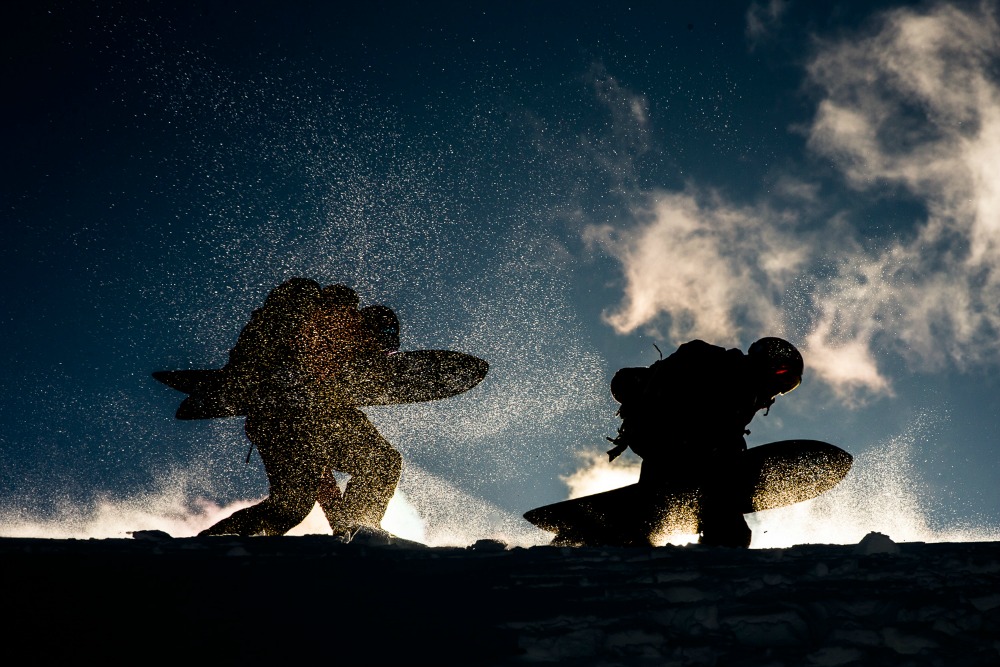
Christenson, of course, is hard at work. He’s about to start shaping next year’s snow designs and is also busy building some of the world’s best big–wave boards for surfers like Ian Walsh and Greg Long. Both of whom trust Christenson to make the boards that they’ll use while riding the biggest waves on the planet.
At one point, Christenson stops sanding the foam blank he’s working on and points out the advantage that shaping surfboards has over snowboards. “With surfboards,” he explains, “they’re custom–made for each surfer so we can try all sorts of different designs and then constantly refine the shapes and curves through feedback from the surfers riding them and figure out what works best. With snowboards, the molds are super expensive and you can only produce a few models every year, so changing things up is a pretty slow process.”
He returns to sanding the board for another minute or two before pausing again and saying, “I guarantee you that if snowboards and skis were shaped like surfboards they would look totally different than the way they look right now. So, in my opinion we’re really just getting started.”




